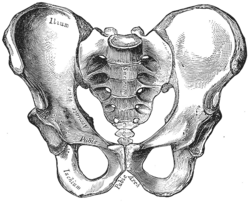Ischial
| Pelvis | |
|---|---|

Male type pelvis
|
|

Female type pelvis
|
|
| Details | |
| Identifiers | |
| Latin | Pelvis |
| MeSH | D010388 |
| TA | A01.1.00.017 |
| FMA | 9578 |
|
Anatomical terms of bone
[]
|
|
The pelvis (plural pelves or pelvises) is either the lower part of the trunk of the human body between the abdomen and the thighs (sometimes also called pelvic region of the trunk) or the skeleton embedded in it (sometimes also called bony pelvis, or pelvic skeleton).
The pelvic region of the trunk includes the bony pelvis, the pelvic cavity (the space enclosed by the bony pelvis), the pelvic floor, below the pelvic cavity, and the perineum, below the pelvic floor. The pelvic skeleton is formed in the area of the back, by the sacrum and the coccyx and anteriorly and to the left and right sides, by a pair of hip bones.
The two hip bones connect the spine with the lower limbs. They are attached to the sacrum posteriorly, connected to each other anteriorly, and joined with the two femurs at the hip joints. The gap enclosed by the bony pelvis, called the pelvic cavity, is the section of the body underneath the abdomen and mainly consists of the reproductive organs (sex organs) and the rectum, while the pelvic floor at the base of the cavity assists in supporting the organs of the abdomen.
In mammals, the bony pelvis has a gap in the middle, significantly larger in females than in males. Their young pass through this gap when they are born.
The pelvic region of the trunk is the lower part of the trunk, between the abdomen and the thighs. It includes several structures: the bony pelvis, the pelvic cavity, the pelvic floor, and the perineum. The bony pelvis (pelvic skeleton) is the part of the skeleton embedded in the pelvic region of the trunk. It is subdivided into the pelvic girdle and the pelvic spine. The pelvic girdle is composed of the appendicular hip bones (ilium, ischium, and pubis) oriented in a ring, and connects the pelvic region of the spine to the lower limbs. The pelvic spine consists of the sacrum and coccyx.
...
Wikipedia
